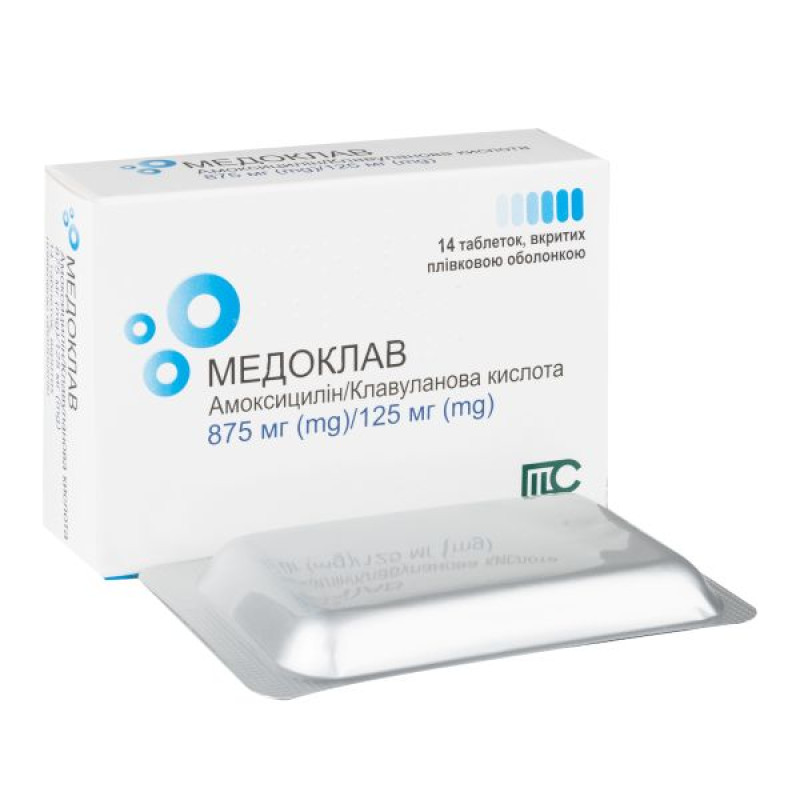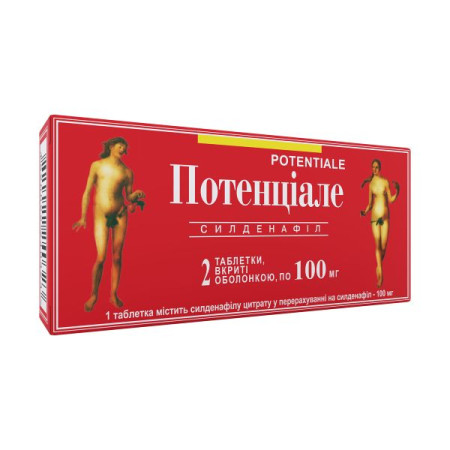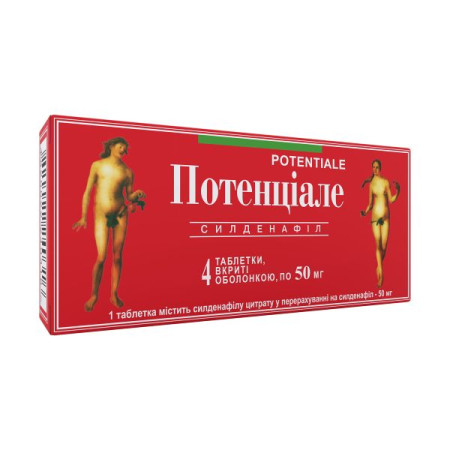Medoklav film-coated tablets 875 mg/125 mg No. 14

Instructions for Medoklav film-coated tablets 875 mg/125 mg No. 14
Composition
active ingredient: 1 film-coated tablet contains amoxicillin trihydrate 1004.0 mg equivalent to amoxicillin 875 mg, potassium clavulanate 148.9 mg equivalent to clavulanic acid 125 mg;
excipients: microcrystalline cellulose, sodium starch glycolate (A), colloidal anhydrous silicon dioxide, magnesium stearate, film coating contains: hydroxypropylmethylcellulose, propylene glycol, polyethylene glycol 6000, talc, titanium dioxide (E 171).
Dosage form
Film-coated tablets.
Main physicochemical properties: white, biconvex, capsule-shaped tablets, film-coated, with core dimensions of 21.5 mm x 10.0 mm.
Pharmacotherapeutic group
Antibacterial agents for systemic use.
ATX code J01C R02.
Pharmacological properties
Pharmacodynamics
Amoxicillin is a semisynthetic antibiotic with a broad spectrum of antibacterial activity against many gram-positive and gram-negative microorganisms. Amoxicillin is sensitive to beta-lactamase and undergoes degradation under its influence, therefore the spectrum of activity of amoxicillin does not include microorganisms that synthesize this enzyme. Clavulanic acid has a beta-lactam structure similar to penicillins and inactivates beta-lactamase enzymes characteristic of microorganisms resistant to penicillins and cephalosporins. In particular, it has pronounced activity against clinically important plasmid beta-lactamases, which are often responsible for the emergence of cross-resistance to antibiotics. The presence of clavulanic acid in Medoklav protects amoxicillin from degradation by beta-lactamase enzymes and expands the spectrum of antibacterial action of amoxicillin, including many microorganisms resistant to amoxicillin and other penicillins and cephalosporins.
The microorganisms listed below are classified according to their susceptibility to amoxicillin/clavulanate in vitro.
Sensitive microorganisms
Gram-positive aerobes: Bacillus anthracis, Enterococcus faecalis, Listeria monocytogenes, Nocardia asteroids, Streptococcus pyogenes, Streptococcus agalactiae, other beta-hemolytic Streptococcus species, Staphylococcus aureus (methicillin-susceptible strains), Staphylococcus saprophyticus (methicillin-susceptible strains), coagulase-negative staphylococci (methicillin-susceptible strains).
Gram-negative aerobes: Bordetella pertussis, Haemophilus influenza, Haemophilus parainfluenzae, Helicobacter pylori, Moraxella catarrhalis, Neisseria gonorrhoeae, Pasteurella multocida, Vibrio cholera.
Others: Borrelia burgdorferi, Leptospirosa icterohaemorrhagiae, Treponema pallidum.
Gram-positive anaerobes: Clostridium species, Peptococcus niger, Peptostreptococcus magnus, Peptostreptococcus micros, Peptostreptococcus species.
Gram-negative anaerobes: Bacteroides species (including Bacteroides fragilis), Capnocytophaga species, Eikenella corrodens, Fusobacterium species, Fusobacterium nucleatum, Porphyromonas species, Prevotella species.
Strains with possible acquired resistance
Gram-negative aerobes: Escherichia coli, Klebsiella oxytoca, Klebsiella pneumonia, Klebsiella species, Proteus mirabilis, Proteus vulgaris, Proteus species, Salmonella species, Shigella species.
Gram-positive aerobes: Corynebacterium species, Enterococcus faecium, Streptococcus pneumonia, Streptococcus viridans species.
Non-susceptible microorganisms
Gram-negative aerobes: Acinetobacter species, Citrobacter freundii, Enterobacter species, Hafnia alvei, Legionella pneumophila, Morganella morganii, Providencia species, Pseudomonas species, Serratia species, Stenotrophomas maltophilia, Yersinia enterolitica.
Others: Chlamydia pneumonia, Chlamydia psittaci, Chlamydia species, Coxiella burnetti, Mycoplasma species.
Pharmacokinetics
Both components of Medoklav (amoxicillin and clavulanic acid) are completely soluble in aqueous solutions at physiological pH values. Both components are rapidly and well absorbed after oral administration. Peak serum concentrations are reached approximately 1 hour after oral administration. Absorption of Medoklav is improved when taken at the beginning of a meal.
Doubling the dose of Medoklav leads to a doubling of its concentration in the blood serum. Both components of the drug bind poorly to blood proteins, about 70% remain in a free state in the blood serum.
Indication
Treatment of bacterial infections in adults and children caused by microorganisms sensitive to Medoklav:
· acute bacterial sinusitis;
· acute otitis media;
· confirmed exacerbation of chronic bronchitis;
· community-acquired pneumonia;
· cystitis;
· pyelonephritis;
· skin and soft tissue infections, including cellulitis, animal bites, severe dentoalveolar abscesses with widespread cellulitis;
· infections of bones and joints, including osteomyelitis.
Contraindication
Hypersensitivity to any components of the drug, to any antibacterial agents of the penicillin group.
History of severe hypersensitivity reactions (including anaphylaxis) associated with the use of other beta-lactam agents (including cephalosporins, carbapenems or monobactams).
History of jaundice or liver dysfunction associated with the use of amoxicillin/clavulanate.
Interaction with other medicinal products and other types of interactions
Concomitant use of probenecid is not recommended. Probenecid reduces renal tubular secretion of amoxicillin. Concomitant use with Medoklav may lead to prolonged elevation of amoxicillin blood levels, but does not affect clavulanic acid levels.
Concomitant use of allopurinol during treatment with amoxicillin may increase the likelihood of allergic skin reactions. There are no data on the simultaneous use of Medoklav and allopurinol.
Like other antibiotics, Medoklav may affect the intestinal flora, which will lead to a decrease in the reabsorption of estrogens and a decrease in the effectiveness of combined oral contraceptives.
There have been isolated reports of increased INR in patients treated with acenocoumarol or warfarin and taking amoxicillin. If such use is necessary, prothrombin time or INR should be closely monitored with the addition or withdrawal of Medoklav treatment.
Application features
Before initiating therapy with Medoklav, it is necessary to accurately determine the presence of a history of hypersensitivity reactions to penicillins, cephalosporins or other allergens.
Serious and sometimes fatal cases of hypersensitivity (anaphylactoid reactions) have been reported in patients receiving penicillin therapy. Such reactions are more likely to occur in patients with a history of hypersensitivity to penicillins (see section 4.3). If an allergic reaction occurs, amoxicillin/clavulanate should be discontinued and appropriate treatment instituted.
If the infection is proven to be caused by microorganisms susceptible to amoxicillin, consideration should be given to switching from amoxicillin/clavulanic acid to amoxicillin in accordance with official recommendations.
Medoklav should not be prescribed if infectious mononucleosis is suspected, since cases of a croup-like rash have been observed when amoxicillin was used for this pathology.
Prolonged use of the drug can sometimes cause excessive growth of microflora insensitive to Medoklav.
The development of erythema multiforme associated with pustules at the beginning of treatment may be a symptom of acute generalized exanthematous pustulosis. In such cases, treatment should be discontinued and further administration of amoxicillin is contraindicated.
Rarely, patients taking Medoclav and oral anticoagulants may experience an abnormal prolongation of prothrombin time (increased international normalized ratio (INR)). Appropriate monitoring is necessary when anticoagulants are taken concomitantly. Dose adjustment of oral anticoagulants may be required to maintain the required level of anticoagulation.
Medoklav should be administered with caution to patients with hepatic dysfunction. Changes in liver function tests have been reported in some patients treated with amoxicillin/clavulanic acid, although the clinical significance of this has not been established.
There have been isolated reports of cholestatic jaundice, which may be severe but is usually reversible. Symptoms may not appear until 6 weeks after completion of treatment.
For patients with impaired renal function, the dose should be adjusted according to the degree of impairment (see section "Method of administration and dosage").
In patients with reduced urine output, crystalluria may occur very rarely, mainly with parenteral administration of the drug. Therefore, to reduce the risk of crystalluria, it is recommended to maintain an adequate balance between fluid intake and urine output during treatment with high doses of amoxicillin (see section "Overdose").
During treatment with amoxicillin, enzymatic reactions with glucose oxidase should be used to determine the level of glucose in the urine, as other methods may give false-positive results.
The presence of clavulanic acid in the drug may cause nonspecific binding of IgG and albumin on erythrocyte membranes, therefore, as a result, a false-positive result is possible when performing the Coombs test.
False-positive Aspergillus test results have been reported in patients receiving amoxicillin/clavulanic acid (using the Bio-Rad Laboratories Platelis Aspergillus EIA test). Therefore, such positive results in patients receiving amoxicillin/clavulanic acid should be interpreted with caution and confirmed by other diagnostic methods.
Use during pregnancy or breastfeeding
As with other medicines, the use of the drug should be avoided during pregnancy, especially in the first trimester, unless the benefit of using the drug outweighs the potential risk.
Both active components of the drug are excreted in breast milk (there is no information on the effect of clavulanic acid on a breast-fed infant). Accordingly, diarrhea and fungal infection of the mucous membranes may occur in the infant, so breastfeeding should be discontinued.
Medoklav can be used during breastfeeding only if, in the opinion of the doctor, the benefit of use outweighs the risk.
Ability to influence reaction speed when driving vehicles or other mechanisms
No negative impact on the ability to drive a car or use other mechanisms was observed, but the possibility of such a side effect as dizziness should be taken into account.
Method of administration and doses
The drug should be used in accordance with official antibiotic therapy guidelines and local antibiotic susceptibility data. Susceptibility to amoxicillin/clavulanate varies between regions and may change over time. Local susceptibility data should be consulted and, if necessary, microbiological determination and susceptibility testing should be performed.
The range of suggested doses depends on the expected pathogens and their sensitivity to antibacterial drugs, the severity of the disease and the location of the infection, the age, body weight and renal function of the patient.
Adults and children over 12 years of age (with a body weight ≥ 40 kg) the daily dose is 1 tablet of Medoklav 875 mg/125 mg 2 times a day.
If higher doses of amoxicillin are required for treatment, other forms of the amoxicillin/clavulanic acid combination should be used to avoid the administration of unnecessarily high doses of clavulanic acid.
The duration of treatment should be determined by the patient's clinical response to treatment. Some infections (e.g. osteomyelitis) require longer treatment.
Dosage in renal impairment.
Medoklav 875 mg/125 mg should only be prescribed for the treatment of patients with creatinine clearance greater than 30 ml/min. Medoklav 875 mg/125 mg should not be used in patients with renal failure with creatinine clearance less than 30 ml/min.
Dosage in liver dysfunction.
Use with caution, monitor liver function at regular intervals. Insufficient data to recommend dosage.
Dosage for elderly patients.
No dose adjustment is required for elderly patients. If necessary, the dose should be adjusted based on renal function.
The tablet should be swallowed whole, without chewing. To reduce the risk of undesirable effects of Medoklav on the gastrointestinal tract, the drug should be taken at the beginning of a meal. This improves the absorption of Medoklav.
Treatment should not be continued for more than 14 days without assessing the patient's condition.
Treatment can be initiated parenterally and then continued orally.
Children.
This form of Medoklav should be used in children over 12 years of age.
Overdose
Overdose may be accompanied by gastrointestinal symptoms and disturbances of water and electrolyte balance. These phenomena are treated symptomatically, paying attention to the correction of water and electrolyte balance. Cases of crystalluria have been reported, which can sometimes lead to renal failure (see section "Special instructions").
Medoklav can be removed from the bloodstream by hemodialysis.
Adverse reactions
Infections and infestations: candidiasis of the skin and mucous membranes.
Blood and lymphatic system: reversible leukopenia (including neutropenia), thrombocytopenia, reversible agranulocytosis, hemolytic anemia, increased bleeding time and prothrombin index.
Immune system: angioedema, anaphylaxis, serum sickness syndrome, allergic vasculitis.
Nervous system: dizziness, headache, reversible hyperactivity and convulsions. Convulsions may occur in patients with impaired renal function or in those receiving high doses of the drug.
Digestive tract: diarrhea, nausea, vomiting, indigestion, antibiotic-associated colitis (including pseudomembranous colitis and hemorrhagic colitis), black hairy tongue.
Nausea is more commonly associated with high doses of the drug. The above-mentioned gastrointestinal symptoms can be reduced by taking the drug at the beginning of a meal.
Hepatobiliary reactions: moderate increases in AST and/or ALT have been observed in patients treated with beta-lactam antibiotics, but the clinical significance of this has not been established; hepatitis, cholestatic jaundice. These phenomena have occurred with the use of other penicillins and cephalosporins.
Hepatitis occurred mainly in men and elderly patients, and may be associated with long-term treatment with the drug.
Such phenomena occurred very rarely in children.
Symptoms of the disease occur during or immediately after treatment, but in some cases may occur several weeks after the end of treatment. These phenomena are usually reversible. Fatal cases have been observed extremely rarely (less than 1 report per approximately 4 million prescriptions), which always occurred in patients with severe underlying disease or in patients who are simultaneously treated with drugs that have a negative effect on the liver.
Skin and subcutaneous tissue: skin rash, pruritus, urticaria, erythema multiforme, Stevens-Johnson syndrome, toxic epidermal necrolysis, bullous exfoliative dermatitis, acute generalized exanthematous pustulosis.
If any allergic dermatitis occurs, treatment should be discontinued.
Kidneys and urinary system: interstitial nephritis, crystalluria (see section "Overdose").
Expiration date
2 years.
Storage conditions
Store at a temperature not exceeding 25 °C in the original packaging, out of the reach of children.
Incompatibility.
Unknown.
Packaging
7 tablets in a blister; 2 blisters in a cardboard box.
Vacation category
According to the recipe.
Producer
Medochemie LTD.
48 Iapetou street, Agios Athanasios Industrial Area, 4101, Agios Athanasios, Limassol, 4101, Cyprus/48 Iapetou street, Agios Athanasios Industrial Area, 4101, Agios Athanasios, Limassol, 4101, Cyprus.
There are no reviews for this product.
There are no reviews for this product, be the first to leave your review.
No questions about this product, be the first and ask your question.










